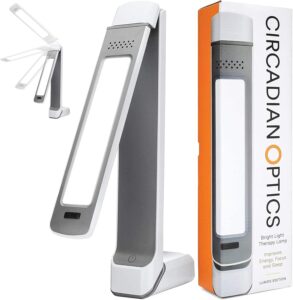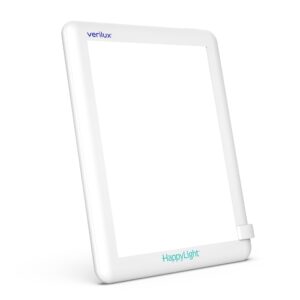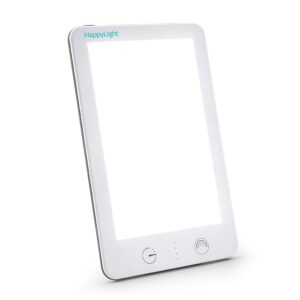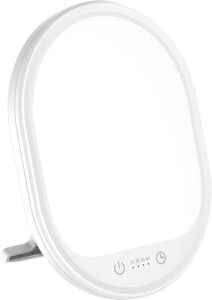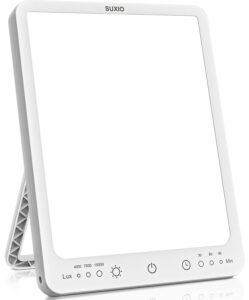Introduction:
Seasonal depression hits millions of people when fall and winter roll around. Less sunlight means mood swings, low energy, and sometimes trouble sleeping. Let’s fix that with some of the best light therapy lamps.
Light therapy lamps step in by shining bright artificial light that mimics sunlight, which can ease symptoms of seasonal depression.
Light therapy works by exposing your eyes to bright light at certain times. This can help reset your body clock and often boosts mood and energy.
Most doctors suggest using light therapy lamps in the morning for 20 to 30 minutes. It’s usually safe and causes fewer side effects than a lot of medications.
Brightness is the main thing to check when picking a light therapy lamp. Look for lamps with 10,000 lux, which is the standard intensity.
Other things to think about should be the size of the light surface, UV filtering, and whether you can angle the lamp for your routine. We tested a bunch of lamps to find the ones that really help and feel good to use.
Circadian Optics Lumos 2.0
This lamp works well for people who want a flexible, stylish option for their desk.
Pros
- The folding mechanism lets us angle the light panel in tons of ways
- Doesn’t hog desk space and stays steady with its weighted base
- Touch controls make it a breeze to use
Cons
- The tall, narrow style can seem a bit tippy when fully extended
- Light is less even than what you get from a wide panel
- Costs more than basic light boxes
What really sets this lamp apart is the adjustable design. We can fold and angle the panel to hit our face just right, whether we’re upright or slouching. That flexibility makes it easy to use at our desk.
The compact size is a win. Most lamps crowd your workspace, but this one slips into tight spots. The weighted base keeps it from tipping, even when you move the panel around.
We got a solid 10,000 lux for our morning routine. The light is bright but not blinding, and honestly, we felt more energetic after using it for a few days.
The narrow panel does mean you have to sit right in front of it to get full benefit. Wider lamps let you move around more and still catch enough light.
Verilux HappyLight Lucent
This lamp is great for anyone who wants simple light therapy without fuss or bulky gear.
Pros
- Just one button
- Thin and light, so it fits anywhere and travels well
- Bright, comfortable light that doesn’t give us headaches
Cons
- Stand feels flimsy and could use some beefing up
- Needs to stay plugged in
- Cord takes up an outlet and limits placement
The one-button setup is a breath of fresh air after lamps with too many controls. Press and go. It’s perfect for mornings when you’re half awake and don’t want to mess with settings.
The slim profile is a bonus. We moved it from bedroom to office with no hassle. The stand lets you adjust the angle, but honestly, it’s not the sturdiest.
The light feels gentle on the eyes, even during longer sessions. No flicker, no weird hot spots. We felt a nice bump in energy, which is the whole point.
Being corded means you can’t use it just anywhere. We wished for a longer cord or battery power. The stand also wobbles if you bump your desk, which gets annoying.
Verilux HappyLight Lumi Plus
This lamp stands out for its brightness controls and portability, though the top setting is intense at first.
Pros
- Three brightness settings so you can ease in or go full blast
- Thin, tablet-like shape is easy to move around
- Timer shuts it off automatically
Cons
- Top brightness feels like staring into the sun at first
- Small buttons are tough to press accurately
- Takes up more space than you’d guess from the photos
We liked having multiple brightness options. Starting low in the morning and switching to medium while working felt just right.
The timer became a favorite. Set it and forget it, no more accidentally leaving the lamp on for hours.
We carried this lamp from kitchen to office without a problem. The detachable stand made it easy to set up wherever we wanted.
The highest brightness caught us off guard. We suggest starting with short sessions on the lowest setting before cranking it up.
Erligpowht Light Therapy Lamp
This little lamp packs a punch with timers and brightness options, though we’re a bit wary about long-term durability.
Pros
- Tablet style makes it easy to move or bring to work
- Four timer settings from 15 to 60 minutes
- Touch controls and three brightness levels for flexibility
Cons
- Some units stop working after a few months
- Even the lowest setting can be too bright for sensitive eyes
- Stand could be sturdier for daily use
We got good results using it during our morning routine. The 10,000 lux output feels like real sunlight, minus the UV risk.
The timer is handy for busy mornings. Just set it and get on with your day. Touch controls respond fast, so switching brightness is easy.
It fits on most desks or counters and feels light to carry around. The rotating stand is nice for getting the angle just right.
The stand wobbles if you move it a lot, and the brightest setting is almost too much in a dark room. We’ve seen some reports about the lamp failing after a few months, which is a bit concerning.
SUXIO Light Therapy Lamp
This budget friendly lamp is great if you want basic light therapy without breaking the bank.
Pros
- Three brightness levels so you can start low and build up
- Timer with memory remembers your last settings
- Small and light
Cons
- Touch controls are confusing and don’t always work right
- Short power cord limits where you can put it
- Some units die after a few months
We’ve used this lamp for our morning routine, and the brightness is solid for the price. The three levels help you ease in, and the highest mode is plenty for a quick 20 minute session.
The timer works well once you figure out the controls. It’s nice that it remembers your settings. The touch buttons took some trial and error, though.
It’s the right size to sit next to a monitor or on a nightstand. Light enough to move around if you want to use it in different rooms. The stand lets you angle it for your face, which is key.
The power cord is shorter than we’d like, so you might need an extension. USB power is handy for travel, but you’ll need your own wall adapter.
Buying Guide
When you’re picking out a light therapy lamp, there are a few features you’ll want to pay attention to. These details can make or break your experience.
Lamp | Brightness | Portability | Best For |
Circadian Optics Lumos 2.0 | 10,000 lux | Compact, foldable design | Desk use with adjustable angles |
Verilux HappyLight Lucent | 10,000 lux | Slim, lightweight, easy travel | Simple, one-button use |
Verilux HappyLight Lumi Plus | 10,000 lux with 3 levels | Tablet-like, portable | Users wanting brightness control + timer |
Erligpowht Light Therapy Lamp | 10,000 lux with 3 levels | Lightweight, easy to move | Budget-friendly with timer settings |
SUXIO Light Therapy Lamp | 10,000 lux with 3 levels | Small, travel-friendly, USB powered | Basic light therapy at low cost |
Light Intensity
Light intensity is a huge deal when it comes to these lamps. We really want something that puts out 10,000 lux at about 24 inches away.
That’s what doctors usually suggest for managing seasonal depression. Some lamps have adjustable brightness, which is pretty handy if you’re sensitive or just want to tweak things.
Light Type
Honestly, LED lights are the way to go. They last longer and don’t suck up much energy, which is a win-win.
It’s smart to steer clear of UV-producing lamps since those can mess with your skin and eyes. Full spectrum bulbs are a solid pick too. They give off a sunlight vibe without the UV drama.
Size and Design
| Feature | What to Look For |
|---|---|
| Size | Big enough to fill your field of vision, so you actually get the benefit |
| Angle | Adjustable tilt for proper positioning |
| Base | Sturdy enough that it won’t tip over if you bump your desk |
Safety Features
Certifications matter, look for things like FDA approval or similar safety marks. Even light distribution is important, so you don’t get weird hot spots.
If the lamp has a timer, that’s a bonus. Most folks stick with 20-30 minute sessions, so it’s nice not to lose track of time.
Price and Warranty
Good light therapy lamps usually cost somewhere between $50 and $200. It’s smart to check the warranty. How long it lasts and what it actually covers.
Honestly, a longer warranty might hint at a better quality lamp, but it’s not a guarantee. Still, peace of mind goes a long way when you’re making a purchase like this.
So, don’t rush it. Take your time, weigh your options, and pick something that feels right for your needs and budget. Happy lamp hunting!
Support the Adventure
To make your walls less boring, check out my photography portfolio and bring a piece of the wild and my story into your home.
If you’d like to fuel future adventures, you can donate a coffee on Ko-Fi. Every cup keeps me chasing sunrises and stories.
When you shop using my affiliate links, every click helps support this blog at no extra cost to you. It’s a small way to keep Unicorn Adventure alive and kicking while I keep exploring.
Subscribe to my mailing list for future updates, new stories, and behind-the-scenes adventures.
Stay connected with me on Instagram and Facebook for more photos and daily inspiration.
Thanks for being part of the journey, Unicorn Squadron!



